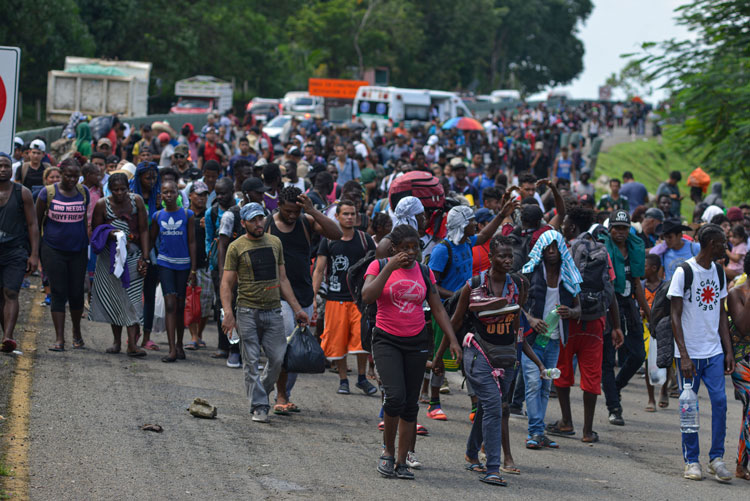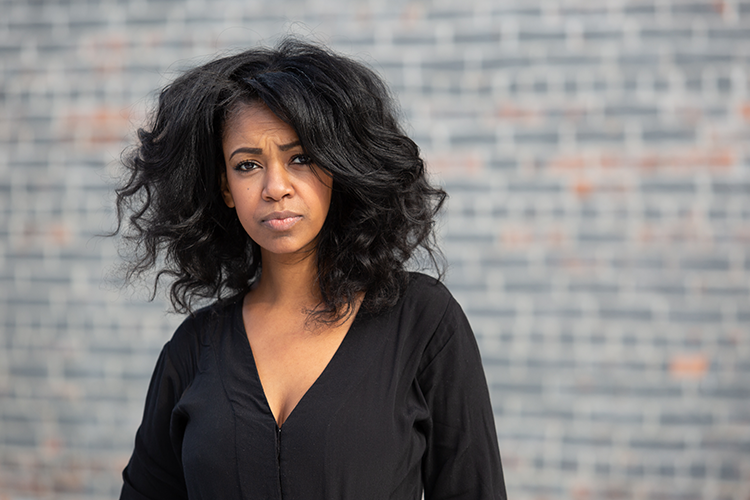Persecuted and marginalized: Black LGBTQ immigrants face unique challenges

Migrants from Africa, Cuba, Haiti and other Central American countries walk down Highway 200 en route to Huixtla near Tapachula, Chiapas state, Mexico, to the southern border of the United States on Oct. 12, 2019. AP Photo by Isabel Mateos.
About eight weeks after the first COVID-19 diagnosis in the U.S., the Department of Homeland Security shut down all immigration ports of entry to nonessential travel, including immigrants arriving to the southern border seeking asylum. But even as the border closure put a halt to the flow of people trying to enter the country, it created new challenges for immigration lawyer Tsion Gurmu.
As the first legal director for the Black Alliance for Just Immigration, Gurmu had just started traveling to Mexican cities to advise the growing number of immigrants from African countries on how they might navigate a slew of new immigration policies that were making it harder for them to pursue asylum.
Major changes in U.S. policy introduced in the last three years left thousands of Black immigrants stranded after precarious journeys through a half dozen or more countries to reach the U.S.-Mexico border.
The border closure in March, combined with new immigration restrictions and an unfavorable U.S. Supreme Court ruling in Department of Homeland Security v. Thuraissigiam against an asylum-seeker pursuing an immigration hearing despite being denied entry, have created unprecedented obstacles for immigrants seeking protection in the U.S., making Gurmu’s work even more vital and challenging.
“Previously, my work has been limited to assisting those individuals who have already entered the U.S. and are seeking asylum and coming to our office,” Gurmu said. “Now, we’ve expanded to reaching out to the folks who are currently residing in Tijuana. We’ll see if it will expand to other cities to provide them with legal services and humanitarian support as well.”
An underserved community
While pursuing her law degree at New York University School of Law, Gurmu observed a growing community of Black immigrants without adequate resources for counseling and legal representation in their efforts to seek protection in the United States.
“While I was doing my internships in law school, I had the opportunity to work on sexual identity-based asylum claims, as well as HIV-based asylum claims, and I was immediately drawn to that kind of work and those particular communities,” Gurmu says. “I was interested in focusing on specifically Black LGBTQ migrants and providing services and a space that had both the language capacity and the cultural competence to not only represent them in their legal claims but to build a community where one did not exist before.”
 Tsion Gurmu is the first legal director for the Black Alliance for Just Immigration. Photo by Mauricio Norona.
Tsion Gurmu is the first legal director for the Black Alliance for Just Immigration. Photo by Mauricio Norona.
Amid policy debates shaped through the lens of Latin American migration, comprehensive legal guidance for Black immigrants who either fear or have faced persecution due to their LGBTQIA+ status had been hard for them to find, and Gurmu wanted to change that.
As a third-year law student, Gurmu’s work on behalf of Rohan Wilson, a Jamaican native who found his way to New York City, is one of her early successes. Wilson says Gurmu saved his life.
“Going back to Jamaica wasn’t an option,” Wilson said in an Equal Justice Works video describing Gurmu’s legal assistance in his asylum case. “If you’re not considered heterosexual in my country, it is considered a sin. I came to the United States to flee from persecution—being beaten, probably being killed for who I am.”
U.S. Citizenship and Immigration Services granted Wilson asylum in May 2015.
After earning her JD, Gurmu spent two years at the African Services Committee as a 2015 Equal Justice Works fellow where she created a legal specialization, support group and storytelling project for LGBTQIA+ African and Caribbean immigrants.
Since 1981, ASC had served as a first stop for Black immigrants who made their way to New York after escaping political unrest in their homelands. But Gurmu’s fellowship project was the organization’s first program to offer legal and social services to immigrants escaping persecution based on LGBT claims.
“We saw an exponential rise in folks leaving the continent and applying for asylum based on their LGBT status,” ASC Director of Advocacy Amanda Lugg recalls. “We saw very quickly that we needed to provide additional supportive services to that community. Tsion was funded to provide legal services to those seeking asylum.”
After Gurmu left, ASC sought and received funding through the New York State Department of Health to continue the initiative she launched. “It’s really fabulous,” Lugg says. “We’re providing mental health counseling, employment opportunities, intervention and health and wellness, as well as bimonthly support groups.”
The Black immigrant experience
After arriving in New York from Nigeria in 2004, Ola Osaze found the community of Black LGBT immigrants disconnected and isolated from resources that would enable them to navigate legal challenges specific to their lives.
Since then, Osaze has worked to create welcoming spaces for Black immigrants. In collaboration with the Transgender Law Center he created the Black LGBTQIA+ Migration Project, which collaborates with Gurmu and BAJI to highlight legal obstacles Black LGBT immigrants face and to organize advocacy on their behalf. One of their biggest challenges has been keeping Black immigrants with LGBT claims out of detention centers.
“If they do get bond, they have the highest bond amounts, and we’re talking bonds as high as $25,000, $30,000, $35,000,” Osaze says. “And let’s say they are even able to raise the money to cover bond. ICE, in many cases, will refuse to release them because of ‘identification issues.’”
Black immigrants living in U.S. cities while awaiting legal proceedings must navigate the immigration system while also dealing with prejudices based on race and sexual orientation. When he first arrived in New York City at the age of 16 from his native Barbados a dozen years ago, Jerome Jones felt overwhelmed.
“As soon as you get here, you’re like, ‘Wait, I’m undocumented? What does this actually mean? I need to do this … I need to do that,’” Jones says. “That process in itself is really scary because a lot of this information isn’t information that’s readily available.”
Jones spent four to five years looking for an attorney to take his case. After filing an application for asylum, he says he had to wait another seven years for an interview.
“I found myself in many positions before where I could not understand what was happening, and I’m just like, I don’t know where to get this information from,” Jones said. “When I did have folks to talk to, I was given a lot of information from a lens that wasn’t a Black lens. That was sometimes very dangerous for me as a Black person to navigate through some of those things that I was being told to do.”
Jones managed to land on his feet. He was granted asylum in March 2020—just before the immigration courts closed. He lives in NYC and found employment with BLMP.
Although the LGBT community in the U.S. has gained greater acceptance and protection from discrimination and now can safely participate in Pride parades and live openly in major U.S. cities, there’s no safe space for the Black LGBTQIA+ community. Neither will you likely find LGBT immigrants representing at demonstrations against racial injustice.
“We try to avoid spaces where there is law enforcement,” says Wahira Labelle, who came to the U.S. as a refugee about a decade ago and is working with Osaze and BLMP to create resources for Black trans immigrants.
“There’s a lot of Black LGBT migrants that are undocumented. When Black Lives Matter go and rally, we advise them to not participate because we are not Americans. You don’t want to risk the chance of running into the cops.”
 Image from Shutterstock.com.
Image from Shutterstock.com.
Stuck at the border
Up until the coronavirus outbreak, LGBT immigrants who arrived at ports of entry could request asylum and receive permission to stay in the U.S., pending a future hearing if they passed an interview providing evidence of persecution based on LGBT status.
Although the U.S. Citizenship and Immigration Services doesn’t track asylum applications by reason for requesting entry, the number of immigrants seeking asylum in the U.S. has been growing dramatically over the past decade. In 2011, the Obama administration asked DHS and other agencies to establish policies that offered protection for LGBT refugees and asylum-seekers.
An estimated 3,000 Black immigrants from countries that have laws that persecute or criminalize homosexuality—including Angola, Ethiopia, Cameroon, Ghana, the Republic of the Congo and Sierra Leone—have created a tent city in Tapachula, which borders Mexico and Guatemala. They have lived in tent cities while waiting for visas to proceed north to the U.S.-Mexico border.
Prior to the pandemic, Trump administration policies required them to either remain in Mexico while awaiting a hearing or first seek asylum in one of the countries they had crossed before reaching the U.S. The “safe-third-country” agreement some Latin American countries had struck with the White House allowed the U.S. to send immigrants arriving at the southern border back to those countries.
Under Gurmu’s direction, BAJI has been helping immigrants find a place to live in Mexican cities while they wait for U.S. immigration courts to reopen. “We’ve partnered with LGBT shelters in Tijuana that can provide a safe space for people to live in—especially at a time when they don’t have the money or knowledge of where to go and how to be safe,” Gurmu says.
In legal counseling sessions that have now gone virtual, Gurmu and her colleagues at BAJI work to educate immigrants on U.S. laws and prepare them for credible fear interviews in which they are required to present evidence that they either have or will experience persecution if returned back to their homeland.
During the credible fear interview, asylum-seekers have to describe experiences of persecution, torture or other harm as a result of being lesbian, gay, bisexual, transgender or HIV positive. If the agent determines a credible fear of harm exists, they are allowed to enter the U.S. and continue their request for protection in U.S. immigration court. If the agent doesn’t find their claim credible, they are returned to their homeland.
Since the “remain in Mexico” policy has been in place, fewer asylum-seekers have come back across the border to show up for deportation hearings, according to Syracuse University data.
Increasing capacity
As BAJI ramps up efforts to advocate on behalf of Black immigrants, Gurmu has been working to increase the legal capacity of BAJI to provide direct representation for asylum-seekers.
“If we are able to assist in the process of having the case transferred to NYC, then that is something we do,” Gurmu says. “If not, we’ll work with partners who reside in other cities—Black attorneys who are experienced in working on Black LGBT asylum cases to take on those cases as well.”
Osaze and other advocates see the COVID-19 border closure as part of a long string of anti-immigration efforts by the Trump administration to curb immigration. In July, DHS proposed a policy that would enable immigration agents to consider public health concerns in asylum cases. When borders reopen, Osaze and others who work on behalf of Black LGBTQIA+ immigrants expect challenges for members of the group to continue.
“Even after this COVID moment when the borders are open again, we know that folks crossing at the southern border will be prevented,” Osaze says. That means folks are stranded in places like Tijuana. Accessing housing in the midst of this moment really is near impossible, accessing any kind of income so you can just survive is near impossible.”
Black radical lawyering
As part of her efforts to build community among LGBTQ immigrants, Gurmu also established the Queer Black Immigrant Project, or QBip, an effort she describes as a black radical lawyering initiative that seeks not only to assist people with asylum claims but also finds solutions to why Black immigrants are leaving their homelands. She also wants to utilize her legal skills to find solutions that make it possible for immigrants to safely return to their homelands.
Gurmu hopes a storytelling project she has created as part of QBip will help Black asylum-seekers learn how to share their stories, advocate on their own behalf and build community as they seek refuge.
“It was really important to build that support group, as well as the storytelling project, as a basis for healing and sharing and building community and doing work that’s sort of not legal work but sort of human work,” Gurmu says.
Establishing legal resources and community networks is important as asylees integrate into the U.S., even among African communities in America.
“Every LGBT asylum-seeker is coming with trauma when they arrive here in the country,” says ASC’s Lugg. “Their communities are doubly marginalized, both from their immigration status but also due to their sexual orientation within the community once they get here. Homosexuality is a stigma that unfortunately runs very deep in our community, and so the support networks that they are able to find in this country are freer, but they are still small.”
A decade after arriving in the U.S., becoming part of a community where she can be herself has made life in America a little easier for Labelle. “We are marginalized within the marginalized. I was like, let’s create a space where we all feel safe,” Labelle says.
Firsthand fight
Gurmu’s approach to lawyering and her commitment to the asylee community has come from insights she developed while studying and working on immigration and human rights advocacy projects in the U.S. and her native Ethiopia. But it mostly comes from her family’s experience immigrating to the U.S. as asylum-seekers three decades ago.
Born in a rural part of Ethiopia in the midst of civil war in the late 1980s, Gurmu was separated from her family for about a year when her father, a political activist in a student movement, spent five years as a political prisoner and then fled the country after multiple threats to his family.
The family first settled in Atlanta, and later, a town in Kansas. Gurmu recalls for many years being the only Black student. Over the years, Gurmu’s parents worked to make the community more inclusive to other Africans who were also forced to flee their homelands.
“They played a big role in creating resources for Black immigrants who had just recently arrived in Kansas like helping them to resettle in the United States,” Gurmu said. “Some of the assistance that they received in Atlanta they recreated that in Kansas, which was really cool to see as a young person just watching my parents.”
During her undergraduate years at the University of Chicago studying political science, history, human rights and Black liberation movements, Gurmu began reflecting on her own journey.
“Those folks made me think about my own story as a Black immigrant that came to the United States as an asylum-seeker with family and thinking critically about how was I going to be able to better assist my community—how was I going to make this degree count,” Gurmu says. “We fought for our safety. We fought for our status in this country. And now we are in a position to fight for others.”



